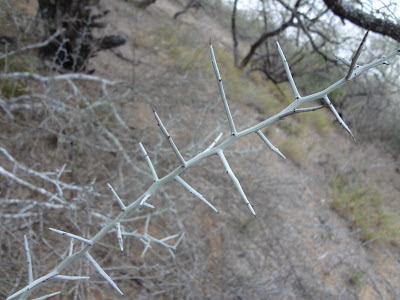At
the end of the Pleistocene (about ten thousand years ago) the great ice sheets were retreating north across
what is now Texas. The lands along The
Rio Grande (or Rio Bravo if you live in Mexico) were at the time a mixture of
dense riparian forests and vast stretches of mixed woodlands spanning north and
south. Prehistoric people had dwelled in
the area for at least one-thousand years camping along waterways. They trapped with snares and deadfalls and by
funneling animals into enclosed areas; and they hunted using a simple catapult-like
tool called an atlatl. The atlatl is an
implement best suited for group use against animals where hunters can surround their prey propelling the small spear-like “darts” into flesh until the
animal succumbs to its wounds. Using an
atlatl in densely forested areas is difficult since the tool must be swung
upwards and then forcibly downwards in order to propel the dart forward. Anyone who has ever tried sneaking up on a
deer in brush or forest land with an atlatl knows how difficult that is without
alerting the animal to your presence. It
wasn’t until the advent of the bow and arrow that lone hunters were able to
successfully venture into the wilds in pursuit of game. The bow and arrow’s stealth enabled a hunter
to dispatch an arrow at close range without alerting the animal. And yet, until that time trapping was the
most successful means by which prehistoric people obtained meat. Traps came in all sizes but most were small
designed for animals like rabbits, raccoons, and birds. A family band could set hundreds of traps in
an area and successfully exploit the faunal population for food. I suspect that small traps were used more
frequently since they could be easily made and spread over an area without
expending too much energy. If local
plants offered appendages useful for traps then all the better since that
reduced energy outflow even more.
In
the brushland and desert regions grow a group of plants ideally suited for
small traps. Two of the plants are
members of the family Rhamnaceae and the other plant belongs to the family
Capparaceae. The first two are given the
scientific names, Ziziphus obtusifolia
(folk name, Lotebush) and Condalia hookeri (folk name, Brasil). The third plant is Koeberlinia spinosa (common name, Junco or Allthorn). Note: the word Junco is pronounced Hoon-Ko. The J is given an “h” sound. Years ago I was camped in the mountains of
New Mexico and an oddly dressed pair walked up on my camp and began asking me
about the birds I’d seen in the area.
Just then a bird called a Junco lit
close by. The pair were both dressed in
identical khaki shirts and Bermuda shorts with knee socks and Aussie-style hats
with turned up brims. They both had gold
ascots and gold name-tags. Identical
hiking boots and binoculars; they seemed like a nice and friendly pair if not a
bit eccentric. The woman saw the Junco
and said, “Look, a joon-co.” Without thinking I said, “Its pronounced hoon-ko, the J is given an “h” sound.” Well,
that was not a good idea since they both obviously thought of themselves as
hot-shot birders and how dare a kid living in a debris hut in the forest tell
them how to pronounce a bird’s name.
They smiled, turned around and walked off.
Lotebush
Brasil
Junco
Koeberlinia spinosa
Both lotebush, brasil and junco can be used as spearing devices for small traps and oftentimes the branches are cut and used as the swing-arms for a trap without any further modification. Very simple and effective, the long spines (up to four inches long) will implant firmly into any animal that wanders into the trap. Most common trap forms include swinging arms moving either horizontally or vertically when the trip line is sprung. A spring driven branch of junco, lotebush or brasil will drive a number of spear-like thorns as if they were daggers into a small animal and hold it in place until the trapper arrives. Oftentimes, the animal is killed instantly.
Mesquite thorns above are long, sharp and strong (I've been stabbed by enough to know these things first hand) but they are not as prevalent on a stem to be sufficient for a good trap.
Tasajillo spines are mean but not strong enough for a trap. Still, the spines are used by nopal rats to line the entrance of their nests. This keeps intruders away. Each spine has a sheath that slips off and remains in the skin where it festers and can cause infection. Stay clear of this cactus.
I
have used lotebush, junco and brasil for small traps over the years. Brasil has built-in barbs from off-shooting smaller thorns and is quite
stiff. As a side note: brasil wood has a
specific gravity of over 1.0 and thus is one of the hardest woods in the
American Southwest. The thorns of these
plants are long and vicious and you should always wear gloves when constructing
a trap. I’ll post a video making a
couple of traps when the weather outside calms down a bit. A blue norther is blowing through as I write
these notes.
Lotebush
Lotebush








